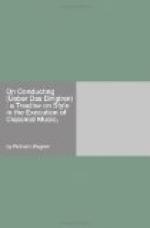with me “on the whole”; but in particular,
people failed to see what I was aiming at. Certainly
(to go on with the example) this first variation of
that lovely sustained theme is of a conspicuously lively
character; when the composer invented it he could hardly
have thought of it as immediately following the theme,
or as being in direct contact with it. The component
parts of the Variation-form are each complete in themselves,
and perhaps the composer was unconsciously influenced
by this fact. But, when the entire piece is played,
the parts appear in uninterrupted succession.
We know from other movements of the master’s
(for instance the second movement of the C minor symphony,
the Adagio of the great quartet in E flat, and above
all from the wonderful second movement of the great
sonata in C minor, Op. III), which are all written
in the form of Variations, but in which the parts
are conceived as standing in immediate connection,
how deftly and delicately the links between the different
variations can be contrived. A player who, in
a case like that of the so-called “Kreutzer-Sonata,”
claims the honour of representing the master in full,
might, at least, attempt to establish some sort of
relation and connection between the sentiment of the
theme and that of the first variation; he might begin
the latter at a more moderate pace, and gradually
lead up to the lively movement. Pianoforte and
violin players are firmly persuaded that the character
of this variation differs considerably from that of
the theme. Let them then interpret it with artistic
discrimination, and treat the first part of the variation
as a gradual approach to the new tempo; thus adding
a charm to the interest the part already possesses
per se.
A stronger case, of similar import, will be found
in the beginning of the first Allegro 6-8 after the
long introductory Adagio of the string quartet in
C sharp minor. [Footnote: Op. 131.] This
is marked “molto vivace,” and the character
of the entire movement is thus appropriately indicated.
In quite an exceptional way, however Beethoven has,
in this quartet, so arranged the several movements
that they are heard in immediate succession, without
the customary interval; indeed they appear to be developed
one from the other according to certain delicate laws.
Thus the Allegro immediately follows an Adagio full
of a dreamy sadness, not to be matched elsewhere in
the master’s works. If it were permitted
to interpret the Allegro as showing a state of feeling,
such as could in some sort be reproduced in pictorial
language, (deutbares Stimmungsbild) one might say that
it shews a most lovely phenomenon, which arises, as
it were, from the depths of memory, and which, as
soon as it has been apprehended, is warmly taken up,
and cherished. Evidently the question, with regard
to execution, here is: how can this phenomenon
(the new Allegro theme) be made to arise naturally
from the sad and sombre close of the Adagio, so that




